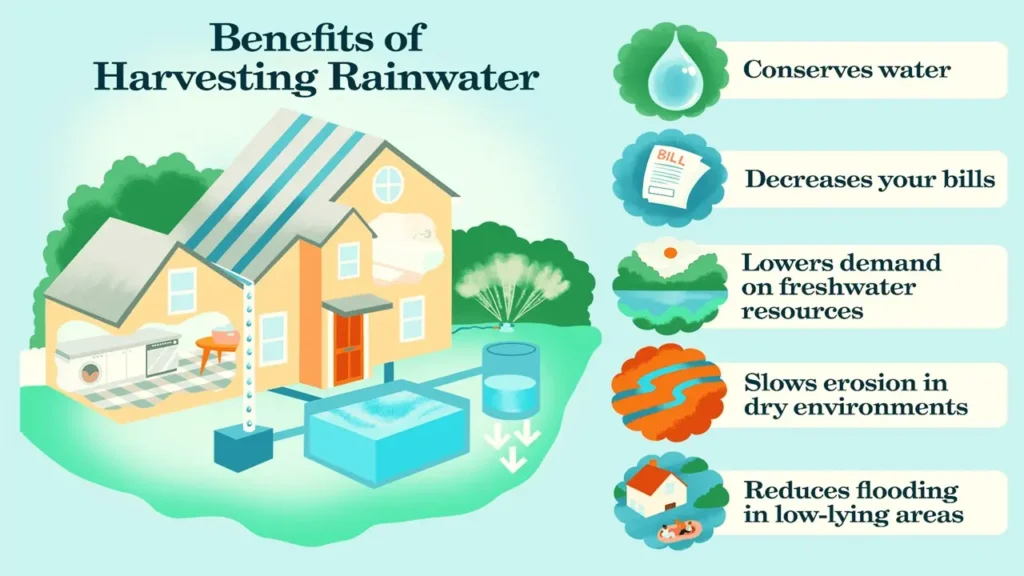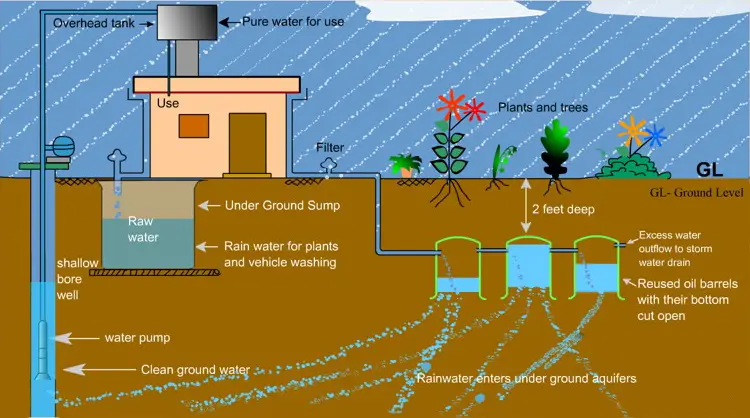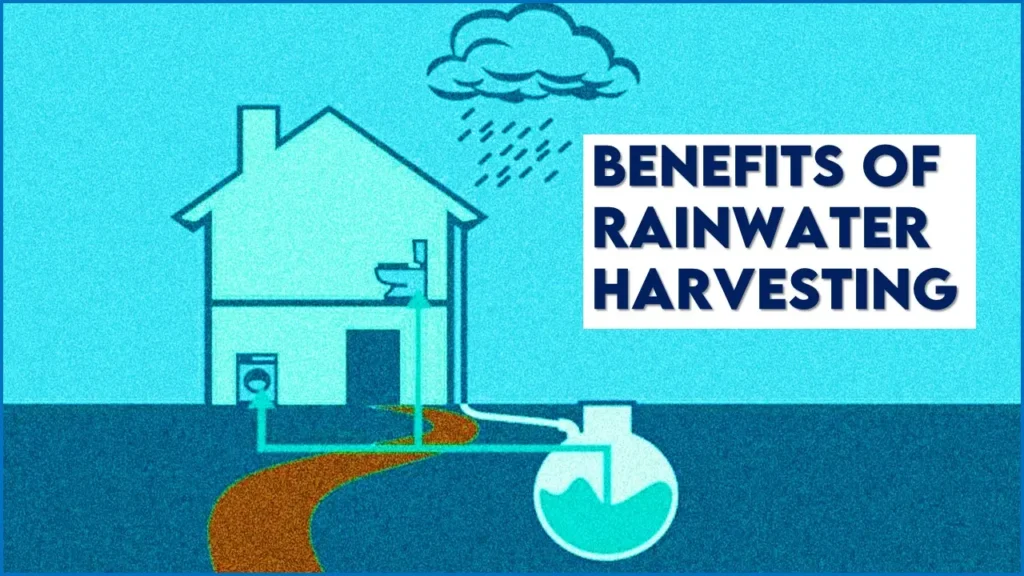Rainwater Harvesting in simple terms is the collection and conservation of rainwater through various structures. Rainwater harvesting can be done through traditional methods by digging pits and all or it can be done by making complex structures that can efficiently accumulate rainwater so that it can be used for daily needs. However, before that, it is imperative to understand Rainwater Harvesting in detail.
What is Rainwater Harvesting?
Rainwater harvesting is a simple and age-old method of collecting and storing rainwater for later use. This is usually done using a system of gutters and pipes that direct the rainwater into a storage tank.
The initial setup cost can be high, and the system needs regular maintenance to keep it working properly and ensure the water is safe to use. Also, the amount of water you can collect is dependent on the rainfall in your area, so it may not be a viable option in dry regions.
I think that gives you a basic idea of Rainwater Harvesting. Now lets go through this article’s core.
Benefit of Rainwater Harvesting
Rainwater harvesting has saved so much rainwater to be reused by us. This has really helped the people in dry regions where rains were scarce. Apart from the many benefits of rainwater harvesting, it is important to note that rainwater harvesting is a sustainable practice. The water that is harvested can be used for any needs other than drinking. They can be used for irrigation also.
Now let us dive into each of the benefits of rainwater harvesting one by one.
1. Environmental Benefits of Rainwater Harvesting
Here are some of the key environmental benefits:
- Rainwater harvesting significantly reduces our reliance on traditional water sources, such as rivers, lakes, and groundwater.
- When rainwater is allowed to run off, it can lead to soil erosion and flooding.
- Over-reliance on groundwater for our water needs can lead to a decrease in the water table, causing wells to run dry and aquifers to deplete.
- Treating and pumping water from municipal sources to our homes requires a significant amount of energy.
- By using harvested rainwater for landscaping and gardening, we can create healthier natural habitats.
- Climate change is expected to lead to more frequent and severe droughts in many parts of the world.
2. Economic Benefits of Rainwater Harvesting
- Rainwater harvesting is not only an environmentally friendly practice but also an economically beneficial one.
- One of the most immediate and tangible benefits of rainwater harvesting is the reduction in water bills.
- The treatment and distribution of municipal water require a significant amount of energy, which is reflected in water utility rates.
- Properties equipped with rainwater harvesting systems often have higher market values.
- In areas prone to drought or where water supply is inconsistent, rainwater harvesting provides a reliable source of water.
- On a larger scale, rainwater harvesting can lead to significant savings on infrastructure costs.
- This includes jobs in manufacturing (tanks, pumps, filters), installation and plumbing, landscaping, and ongoing maintenance and repair.
- During periods of drought, water restrictions may be imposed, which can have a financial impact on businesses that rely heavily on water, such as landscaping, agriculture, and car washes. Having a rainwater harvesting system can provide an alternative water source during these times, helping to mitigate the financial impact of water restrictions.
3. Water Conservation Benefits of Rainwater Harvesting
- Rainwater harvesting is a highly effective method for conserving water.
- Rainwater harvesting reduces the demand for municipal water supplies.
- Over-extraction of groundwater for our water needs can lead to a decrease in the water table, causing wells to run dry and aquifers to deplete.
- Rainwater harvesting encourages the efficient use of water. When people have a finite supply of water (the amount they have harvested), they are more likely to use it wisely.
- In areas prone to drought, rainwater harvesting can provide a valuable water source when other sources become scarce.
- A significant amount of water is lost through leaks in the public water supply system.
- In some rainwater harvesting systems, excess water is directed to local water bodies or to recharge wells, helping to maintain or increase their water levels.

4. Secondary Benefits of Rainwater Harvesting
- Rainwater harvesting is a practice that, beyond its primary benefits, also offers a range of secondary benefits. Here are some of the key secondary benefits:
- Rainwater is naturally soft and free from many of the chemicals found in municipal water supplies, such as chlorine and fluoride.
That wraps up the major benefits of rainwater harvesting. Now let us look at the process of rainwater harvesting in detail.
Also Read
Components of Rainwater Harvesting
A rainwater harvesting system typically consists of several key components. Here’s a detailed explanation:
- Catchment Area: This is the surface upon which the rain falls and is subsequently collected. It’s often the roof of a building, but it can also be a yard, a courtyard, or any other surface where rain falls directly.
- Gutters and Downspouts: These are installed along the edges of the roof to collect and channel the rainwater that falls on the roof. The gutters collect the water and the downspouts direct it to the storage tank.
- Leaf Screens and Roof Washers: These components are used to filter out debris, such as leaves and twigs, and to wash off the first flush of rainwater which may contain contaminants from the roof. This helps to ensure that the water entering the storage tank is relatively clean.
- Storage Tanks or Barrels: This is where the harvested rainwater is stored for future use. The size of the tank depends on the water usage and the catchment area.
- Delivery System: This is the system that delivers the stored water to where it’s needed. In a simple system, this could be a tap at the bottom of the storage tank. In more complex systems, it could involve pumps and distribution pipes to deliver the water to various points of use.
- Treatment System: If the harvested rainwater is to be used for drinking or other domestic purposes, it needs to be treated to make it safe for use. This can involve filtration systems, UV light treatment, or chlorination, depending on the quality of the collected water and its intended use.
- Overflow System: This is a mechanism to deal with excess water when the storage tank is full. The overflow system can direct this water to a secondary storage, to a recharge well, or safely away from the building to prevent flooding.
Now we are ready to look at the processes of rainwater harvesting.
Process of Rainwater Harvesting
Imagine it’s a rainy day. You’re inside, sipping hot chocolate, and you hear the pitter-patter of rain on your roof. Now, what if I told you that the rain falling on your roof could be captured and used? That’s exact process of rainwater harvesting!
Step 1: Catching the Rain
The first step in rainwater harvesting is catching the rain. The surface that the rain falls upon is called the catchment area. In most cases, this is the roof of your house. But it could be any surface where rain falls directly. The bigger the surface, the more rain you can catch.
Step 2: Collecting the Rain
Now, we need a way to collect that rainwater. This is where gutters and downspouts come into play. Gutters are like long, shallow troughs that are fixed under the edges of the roof. They catch the rainwater that falls on the roof and channel it into the downspouts. Downspouts are like pipes that run from the roof to the ground. They guide the rainwater from the gutters into a storage tank.
Step 3: Filtering the Rain
But wait, what about leaves, twigs, and other stuff that might get washed into the gutters along with the rain? We don’t want that gunk in our water, right? That’s why we have leaf screens and roof washers. Leaf screens are like filters that catch leaves and other large debris. Roof washers are special devices that divert the first flush of rainwater, which might contain dust or bird droppings from the roof, away from the storage tank.
Step 4: Storing the Rain
The rainwater that’s collected and filtered is then stored in a storage tank for future use. The tank could be a simple barrel or a large underground cistern, depending on how much water you want to store.
Step 5: Using the Rain
When you need to use the stored rainwater, you have a delivery system in place. This could be as simple as a tap on the bottom of the tank. Or it could be a more complex system with pumps and pipes to deliver the water to different parts of your house.

Step 6: Treating the Rain
If you want to use the harvested rainwater for drinking or cooking, it needs to be treated to remove any remaining impurities. This could involve a filtration system to remove particles, a UV light treatment to kill bacteria and viruses, or a chlorination process to disinfect the water.
Step 7: Dealing with Overflow
What happens if it rains a lot and your storage tank gets full? That’s where the overflow system comes in. It’s a mechanism to deal with excess water when the storage tank is full. The overflow system can direct this water to a secondary storage, to a recharge well, or safely away from the building to prevent flooding.
So, the next time it rains, just think about how that rain could be put to good use through rainwater harvesting!
Also Read
Conclusion
Rainwater harvesting is the process of collecting and storing rainwater for later use. This is an age-old method and has evolved tremendously since. Now we have complex systems to do the same work with much higher efficiency. Today rainwater harvesting offers a plethora of benefits. We have discussed those benefits in detail under different subcategories. The water conservation benefits, environmental benefits, economic benefits, and ancillary benefits.
The effects of global warming and climate change are being experienced first-hand by people. Regions that used to receive abundant rainfall have recorded the lowest-ever rainfalls in recent years. Our world is turning into one big desert because of our activities.


